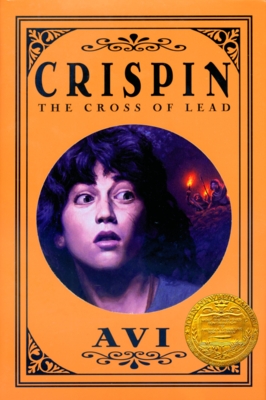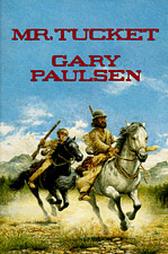
A young, thirteen year old boy known only as Asta's son, discovers from the village priest, Father Quinel, after his mother's death, that he was christened Crispin at birth. Father Quinel promises to reveal additional information to Crispin on the following night, but is murdered before Crispin can return. Hunted by the village steward, John Ayecliffe, who has accused him of stealing and declared him a "wolf's head", a person who is less than human and anyone's prey, Crispin, following Father Quinel's advice, flees the only life he has known, that of a serf in feudal England. He takes with him his only possession, a cross of lead that has an inscription written by his mother, a skill Crispin did not know his mother possessed. He encounters a vagabond juggler named Bear to whom he is forced to swear allegiance. As the character of Bear is slowly revealed to be much more complex than that of a simple "mummer", a deep friendship resembling that of father and child develops between Bear and Crispin. Crispin and Bear head toward the city of Great Wexly where Bear has promised to meet someone on the day of the Feast of John the Baptist. Once there, the story unfolds with nail-biting suspense as both Crispin and Bear are hunted by John Ayecliffe, and Crispin's true identity, the bastard son of Lord Furnival and the daughter of Lord Douglas, reveals why Ayecliffe, relative of the widowed Lady Furnival, wants to see Crispin dead. Widow Daventry, Bear's friend and proprietress of the Green Man Inn of Great Wexly warns, "Beware of all men who confuse their righteousness with the will of God."
Avi's Newbery Award winning tale of the perils of life in feudal England in the thirteenth century serves as a tool for introducing young readers to this time of social injustice and radical change, revealing the strong role that the church played during this time. While this is the story of a young boy, Crispin, finding his own inner strength, the character of Bear as a spy for revolutionaries traveling under the guise of a simple juggler is equally compelling.
Avi. 2002. Crispin: The cross of lead. New York: Hyperion Books. ISBN: 0786826479.

Francis Tucket is traveling west on the Oregon Trail with his family when he receives a new rifle for his fourteenth birthday. When he lags behind the wagon train to practice with his new gun, he is captured by Pawnee. His rescue from the Indians comes in the person of Mr. Jason Grimes, a wily, one-armed mountain man who has a quasi-truce with the Pawnee because he supplies them with gun-powder.
Not liking either of Francis Alphonse Tucket's given names, Mr. Grimes decides to call him Mr. Tucket. In this coming of age novel set in the plains of the Midwest in 1848, Francis truly does become Mr. Tucket, learning from Mr. Grimes how to survive. Their adventures include a chance meeting with the famous mountain man, Jim Bridger, who happens on them while they are trapping beaver.
Although he had passed on an earlier chance to join another wagon train heading to Oregon, Francis is confronted with the realities of the life of a mountain man when Mr. Grimes seeks revenge on an Indian named Braid who had killed his friend, Spot Johnnie. "There were different sets of rules for different people. One set for Mr. Grimes, but, Francis thought, as he reached his horse, there was a different set for him. He was not and did not want to be a 'mountain man'."
Gary Paulsen accurately portrays the inevitable harshness of the life a mountain man during this period in history. His action-packed story alludes to the respect that the Native Americans of the Plains had for their environment while focusing on a young man's realization of what his role is to be in this life. Those who enjoy action-filled adventure stories will not be disappointed in Mr. Tucket.
Paulsen, Gary. 1994. Mr. Tucket. New York: Delacorte Press. ISBN: 0385311699.

After his mother's death, six year old Bud, not Buddy, Caldwell finds himself shuttled between overcrowded orphanages and abusive foster homes during the Great Depression. After the Amos family locks him in a shed filled with hornets and fish-head doorguards for the night, Bud decides to "go on the lam" and look for the man he thinks might be his father, relying on the flimsiest of evidence, his mother's reaction to a blue flyer she brought home not long before her death, promoting a band leader, Mr. Herman E. Calloway and the Dusky Devastators of the Depression. In his quest, he faces head-on many of the hardships endured during the depression, soup-lines at the mission and shantytowns or Hooverville's, as they were known. Using his quick wit and his "Rules and Things for Having a Funner Life and Making a Better Liar out of Yourself," Bud eventually gets a ride with Lefty Lewis, a labor organizer for African American railroad workers, from Flint to Grand Rapids, Michigan where he hopes to find Mr. Herman E Calloway. Although the ending is not what Bud anticipated, he finds his place in the world and leaves readers with a sense of hope for the future.
With many twists and turns and turns in the plot, Christopher Paul Curtis takes readers on a page-turning journey filled with laugh-out-loud humor, moments of trepidation, and ending with a poignant reunion. The first person narrative of Bud allows an insider's view depicting the grim realities of life during the Great Depression for an orphaned ten year old African American boy. Curtis loosely modeled the characters of Lefty Lewis and Herman Calloway on his own grandfathers. In the Afterword he cautions readers to listen to the stories their grandparents tell saying, "By keeping their stories alive you make them, and yourself, immortal." Bud, Not Buddy, a great read aloud for upper elementary children, will spark much discussion about the period in which it is set and Bud's philosophies of life.
Curtis, Christopher Paul. 1999. Bud, not Buddy. New York: Scholastic (by arrangement with Delacorte Press). ISBN: 0439227534.

Shaka, famous leader of the Zulu tribe in South Africa, managed to overcome adversities in his youth and build one of the mightiest nations in Africa. Outcast by the Zulu tribe when he was six for allowing the slaughter of a sheep under his care, Shaka, son of the chief, and his mother, Nandi, were forced to return to her native clan in disgrace. Again, they were rejected by her people during a famine, finally finding a home where they were accepted and Shaka began to thrive. Questioning the tactics and weapons used by his clan, Shaka devised a new, more efficient weapon and organized his men so that they fought as a unit instead of as individuals. Upon the death of his father, Shaka returned to claim his birthright as the chief of the Zulus. He organized the men of the Zulu tribe into one of the finest, most well-trained armies in Africa. Under his leadership, the Zulus came from being a small insignificant tribe to one of the most powerful in Africa.
Author/illustrator Diane Stanley and her husband, Peter Vennema, team up to give young reader's a glimpse of the life of one of Africa's great success stories. The text, rich in African history and filled with tidbits of information about the legendary African leader, is complemented by Diane Stanley's detailed paintings depicting tribal life set against the landscape of southern Africa. Stanley admonishes young readers that while Shaka "ruled through force and fear - that is how he made his soldiers obey him, and that is how his army won battles. It is not an approach that is admired today, as we dream of a world at peace." The story of Shaka can serve as a source of inspiration for those who persevere despite early setbacks.
Stanley, Diane and Peter Vennema. 1988. Shaka: king of the Zulus. New York: Morrow Junior Books. ISBN: 0688073433.
